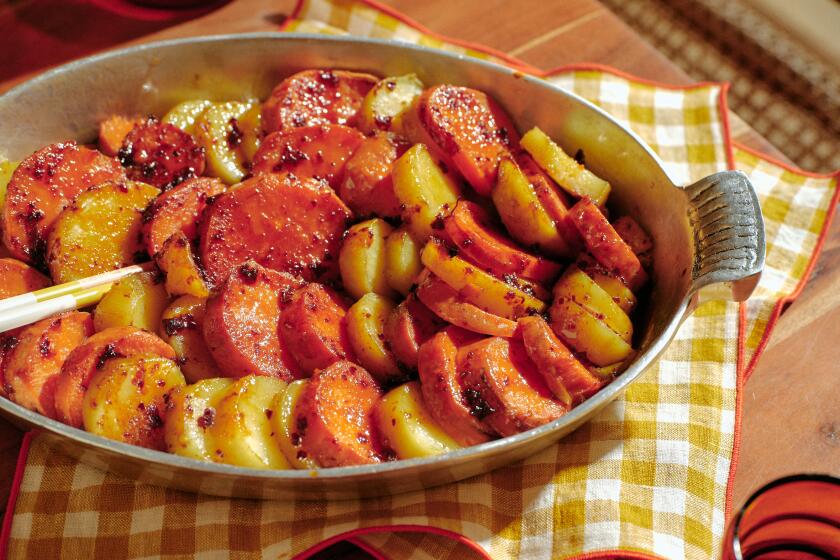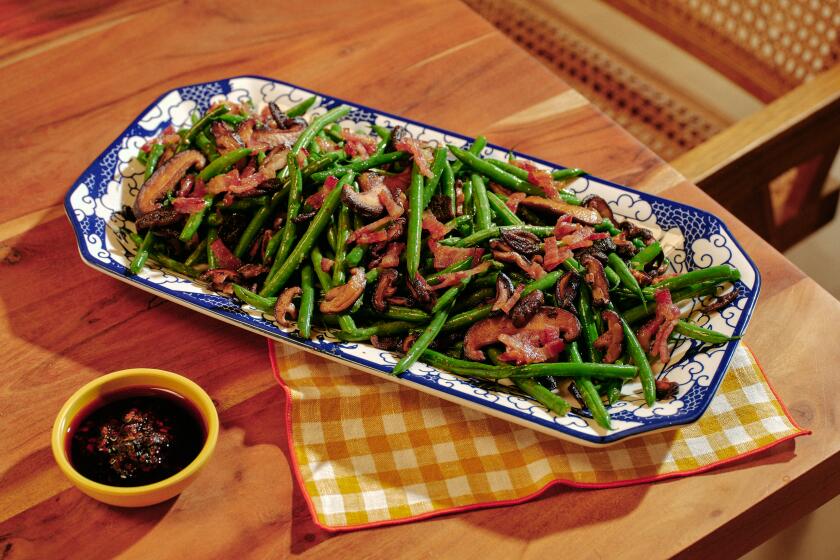Glazed cipollini with pancetta
More redolent, more heady, more burnished, a Thanksgiving table laden with lustrous golden turkey, velvety dark-green kale, burnt-sienna sweet potatoes is probably the richest feast of the year. In the gilded candlelight, it’s hard to resist comparing it to a painting; call it Netherlandish Renaissance or Italian Baroque.
But there’s no still life here. Once dinner gets going, passed plates flash with the deep wine-red hue of the cranberries, the gradations of green on the tiny leaves of Brussels sprouts, the dazzling white of little glazed onions. In between is the sparkle of lifted silverware and crystal glasses.
Inevitably, the nuts-and-bolts discussion of the colors of Thanksgiving comes down to this: “Would you like dark meat or white meat?” But why must it be a choice? Why are turkey eaters so often hard-liners?
I cannot and will not choose; I love them both -- a couple of thin slices of the turkey breast edged with fatty-crispy lacquered brown skin, and a piece of dark meat with its deep flavor and melting texture. I love the way the lean white meat plays against a luscious gravy and the way the rich dark meat is punctuated by a tart burst of cranberry sauce.
And when the turkey is roasted perfectly, so that both the breast and thigh are tender and succulent -- why wouldn’t everyone want the dark and the white meat?
Last year, Times columnist Russ Parsons discovered the best way to roast a turkey. It’s rubbed all over with salt and allowed to cure for three days before roasting. The result was illuminating: Who knew turkey could taste so great and have such an amazing texture? The meat was moist -- almost silky -- but also firm, with deep, concentrated flavor. But as we compared techniques during testing, the best-browned bird was the one that had been brined. We loved the salted bird best, but wished it was more bronzed.
This year, we did it: We improved on the dry-salted turkey recipe so that the dark and white meat were perfectly cooked and the skin was wonderfully crisp and deep golden-brown. The fix? Every day during the curing, we redistributed the salt all over the turkey. And during roasting, we raised the cooking temperature at the end, rather than starting high at the beginning.
What to serve with the perfect bird? You’ll find no set menu in these pages. Instead, here’s a collection of new recipes from Food section writers and a couple of guest contributors; choose what you like from the greens, the oranges, the reds and ivories and golden-browns. There are lima beans strewn with fresh mint, and a sumptuous celery root gratin; a savory bread pudding spiced with sage and thyme, studded with chanterelles and set in a custard enriched with Gruyere and Emmentaler cheeses; spiced pumpkin soup; or sweet potato puree with a hazelnut souffle top. Rosemary and black pepper breads braided together and formed into a wreath make a stunning centerpiece. A pumpkin pie with a bruleed top is served with cardamom-scented whipped cream and candied lemon peel. Another has a cashew crust with a little orange zest mixed in. A cranberry and fig tart is spectacular, especially with a dollop of Cognac whipped cream.
It’s difficult not to want to make all of them.
Put the cipollini in a large bowl and pour over enough boiling water to cover. Let them stand for 2 minutes (if using pearl onions, 1 minute should be enough). Drain the onions and run them under just enough cold water so they’re cool enough to handle. Cut off the stem end of each and peel back the papery skin, which will now be quite soft. In some cases, the top layer will peel off as well. Trim the dark, dry part of the root end, but do not trim too deeply or the cipollini won’t hold together as well.
Dice the pancetta and place it in a skillet with the olive oil over medium-low heat. Cook until the pancetta has rendered its fat and browned, about 15 minutes.
Pour off all but 1 to 2 tablespoons of the fat and add the peeled cipollini to the skillet. Toss to coat with the fat and add the balsamic vinegar, one-fourth cup chicken broth, the rosemary and one-half teaspoon salt. Cover and cook over medium-low heat until the cipollini are tender enough to be easily pierced with a knife, about 20 to 30 minutes (about 20 for pearl onions).
Remove the lid and increase the heat to high. Cook, stirring the cipollini to keep them from scorching, until they have colored slightly and a dark brown crust has formed on the bottom of the pan. Do not let this burn. Add another 2 to 3 tablespoons of chicken broth and stir, scraping the bottom of the pan to release the browned bits and glaze the cipollini. Season with more salt, a splash of balsamic to taste and a generous grinding of black pepper.
Get our Cooking newsletter.
Your roundup of inspiring recipes and kitchen tricks.
You may occasionally receive promotional content from the Los Angeles Times.
















